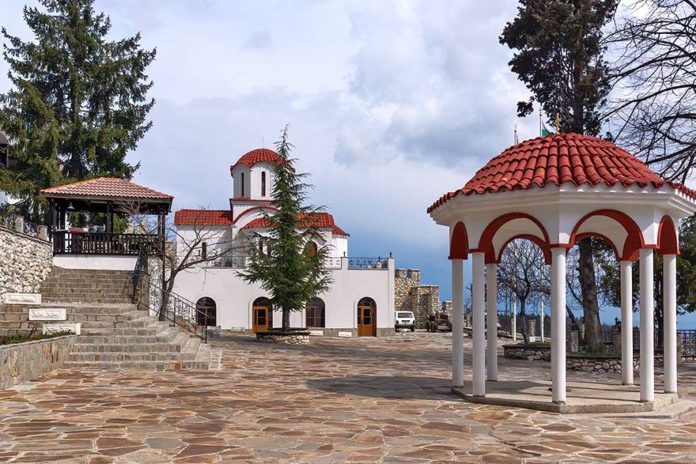Nestled in the serene beauty of its surroundings, Kuklen Monastery holds a captivating tale that intertwines spirituality, education, and cultural legacy. With a history shrouded in mystery, this remarkable monastery stands as a testament to the resilience of Bulgarian heritage. Let us delve into the enchanting story of Kuklen Monastery.
Origins Lost in Time
The exact origin of “St. Cosmas and Damian” remains debated. The earliest mention of the monastery dates back to the 11th century, in a document concerning the properties of the Bachkovo Monastery. Some researchers attribute its construction to the Georgian brothers Gregory and Abasius Bakuriani, who founded the Bachkovo Monastery.
A Healing Oasis of Knowledge
The theory that Kuklen Monastery was founded during the Second Bulgarian Empire (12th-14th century) around a healing spring is widely accepted. Ancient Thracians were said to have been familiar with the spring waters, which were believed to cure madness. During the reign of Tsar Ivan Alexander (1341-1371), the monastery gained recognition for its literary school and cultural influence.
Turbulent Times and Enduring Faith
Despite the challenges of Ottoman rule, Kuklen Monastery remarkably survived. In the 17th century, during the Islamization of Chepino, a staggering 33 monasteries and 218 churches were razed to the ground. However, Kuklen Monastery was protected by the Turkish authorities, as it served as a place of healing for the families of Ottoman rulers. Legends suggest that Bulgarian monks, expelled from the Belitsa Monastery, sought refuge here. It is possible that some of the disciples of Evtimiy of Tarnovo, who accompanied him during his captivity in the nearby Bachkovo Monastery, found sanctuary at Kuklen. They might have brought the renowned Ivan Alexander Pesniyets, a manuscript from 1337 (now preserved in the library of the Bulgarian Academy of Sciences), discovered in the monastery’s attic.
Resilience and Renaissance
Over the centuries, Kuklen Monastery faced destruction and restoration multiple times. Despite these challenges, it continued to serve as a center of literary and educational activity, even during the darkest years of Ottoman rule. In the 16th century, two notable scribes, Hieromonk Anani and Hieromonk Sidor, who migrated from the Gornovodenski Monastery, made their mark as scholars within its walls. With time, the monastery grew economically and evolved into a center for education, training scribes, calligraphers, and copiers of religious books. Its reputation extended beyond Bulgarian lands, reaching distant lands.
Revival and Cultural Splendor
In the late 17th and early 18th centuries, Kuklen Monastery witnessed the rise of its renowned Kuklen Artistic and Calligraphic School. Skilled scribes and calligraphers worked within its premises, imparting knowledge to young grammar students and aspiring calligraphers. Notably, Krastyu Gramatik, although a layperson, transcribed and illustrated numerous liturgical books within the monastery. He was one of the most accomplished Bulgarian calligraphers during the Ottoman era, mastering decorative letters, interlaced ornaments, and exquisite miniatures. The adornments of Krastyu’s choir books are described by writer and artist Nikolay Raynov in his book “Ornamentation and Letters in Slavic Manuscripts of the Plovdiv Library”, published in Sofia in 1925.
A Journey through Centuries
Throughout the Revival period, the monastery also housed a monastic school. Towards the end of the 18th and the beginning of the 19th century, Greek monks took over the monastery, overlaying Bulgarian frescoes with their own but retaining Greek inscriptions. Today, after the restoration of the monastery church, both layers of frescoes are preserved and exhibited.
Kuklen Monastery Today
The Kuklen Monastery remains a beacon of Bulgarian heritage and culture today, illuminating the past and inspiring the future. The Kuklen Monastery is an active women’s monastery. The temple festival is celebrated on July 1st and November 1st, commemorating the memory of Sts. Cosmas and Damian. St. Peter’s Day (June 29th) is also considered a feast day for both the monastery and the town of Kuklen. On this day, a grand three-day fair is organized in the meadows surrounding the monastery, attracting people from all over Bulgaria.
During the temple festival on July 1st, the miraculous healing icon of Sts. Cosmas and Damian are removed from the main church, and a liturgical procession is conducted. This ritual further amplifies the monastery’s longstanding reputation as a healing center.
The legacy of the Kuklen Monastery is an eloquent narration of a resilient cultural heritage that has withstood the test of time and continues to be a beacon of faith, knowledge, and culture. It is a monument of historical significance and a vibrant center of spiritual life, drawing people from near and far to celebrate its rich history and partake in its living traditions.
Embark on a journey through time and spirituality by discovering Bulgaria’s rich monastery heritage.



